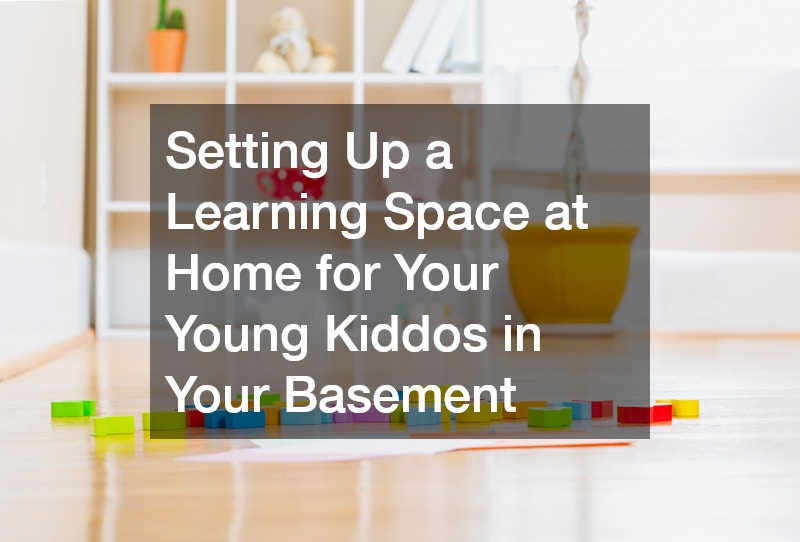
Creating a functional and inspiring learning environment at home for your children can significantly enhance their educational experience. The basement offers a perfect opportunity to design a dedicated space that caters to their academic needs and imaginative growth. This article explores essential considerations for setting up a learning space at home for your little ones in your basement.

Why Take On This Project?
Setting up a learning space at home for your little ones can provide a quiet, engaging environment that fosters focus and creativity. Basements often offer ample space away from household distractions, making them ideal for reading, arts and crafts, and early learning activities.
A structured learning area at home allows kids to establish a routine that supports academic growth. You can set up child-sized furniture, colorful storage bins, and interactive educational tools to keep them engaged. Proper lighting, a comfortable reading nook, and a designated craft station can encourage hands-on learning while making the space fun and inviting.
Basements also provide a controlled environment where you can regulate noise levels and limit distractions. With a well-designed layout, your basement can serve as a multi-purpose space for educational play, sensory activities, and even quiet time for reflection. Adding a chalkboard, whiteboard, or even a projector for educational videos can further enhance the experience.
By dedicating a learning space in your basement, you give your kids a place to explore, create, and develop essential skills in a comfortable setting. It’s an investment in their education and growth while maximizing the unused space in your home.
Plan the Layout
When setting up a learning space at home and planning the layout in your basement, consider the available space and how to best utilize it for your child’s needs. It is important to create distinct zones for different activities, such as reading, art, and educational play. Consulting a drywall contractor can help in making the necessary structural changes to optimize the use of space and ensure a functional layout.
Creating the perfect layout involves selecting suitable flooring materials, which can be obtained from a reputable tile shop. The right flooring choice can affect the comfort, safety, and overall aesthetic of the learning environment, helping transform a space into a versatile educational hub. Remember to leave ample open space for your children to move around freely and explore.
Incorporating built-in storage and shelving solutions can help keep the area organized and clutter-free. A well-organized space encourages a more focused learning experience for your children. With thoughtful planning, you can turn your basement into a playful yet educational sanctuary for your young ones, where they can engage in various projects.
Ensure Adequate Lighting
Lighting is a critical component in setting up a learning space at home. Since basements often have limited natural light, it’s essential to supplement it with suitable artificial lighting. Start by incorporating overhead lighting to ensure the room is bright and evenly lit, which can enhance focus and reduce eye strain.
Strategically placing desk lamps and floor lamps in study areas can provide task-specific lighting for activities such as reading or writing. Additionally, using adjustable lighting fixtures gives you the flexibility to change the intensity of light based on the time of day and specific learning activities. This adaptability makes the area more inviting and functional for young learners.
Consider the color temperature of your light bulbs, opting for those in the daylight spectrum to mimic natural light more closely. This type of lighting can positively influence mood and productivity, creating a pleasant environment. To further enhance the cheerfulness of the space, consider integrating string lights or fun illuminated designs into the decorative scheme.

Choose Essential Furniture
Selecting the right furniture for your basement learning space is crucial when setting up a learning space at home and facilitating a comfortable and productive environment. Choose desks and chairs that are size-appropriate for your children to ensure ergonomic seating positions. Look for furniture that can be easily adjusted as your child grows, preserving the usability of your basement learning space over time.
Multi-functional furniture can serve dual purposes and maximize the use of space. For example, opt for tables that can be extended for larger projects and folded away when not in use. Using custom area rugs can also define different zones within the space, creating distinct areas for focused work or imaginative play.
Comfortable seating options, such as bean bags or small couches, can provide a cozy corner for relaxation and leisure reading. Ensuring that the furniture is safe and child-friendly will create a welcoming learning environment.
Install Proper Flooring
Proper flooring installation is essential for setting up a learning space at home and making it both practical and inviting. Consider hardwood floor installation, which provides a durable and easy-to-clean surface that can withstand the wear and tear associated with active young children. Hardwood not only creates an elegant ambiance but is also a practical choice for educational environments.
Alternatively, you may want to consider soft flooring options like foam or carpeting, especially in areas devoted to play and movement. These materials can help cushion falls and make the space safer for energetic activities. Utilitarian flooring choices contribute to a safer environment for projects for toddlers and parents, adding to the overall functionality.
It’s crucial to ensure that any flooring solution you choose aligns with the aesthetics of the room and complements the chosen furnishings and decorations. Consider engaging with a professional installer to achieve a flawless finish that integrates seamlessly with the room’s design. Well-chosen flooring will create a foundation that supports both learning and play.
Choose Colors and Decorations
The color scheme and decorations you select are essential when setting up a learning space at home that can significantly impact its mood and appeal. Bright, warm colors can make the environment feel lively and welcoming, while softer, muted tones might promote calmness and focus. Consider the interests of your children when choosing colors to inspire a sense of ownership and enthusiasm in them.
Decorating with thematic elements, like tropical wallpaper, can capture children’s imaginations and make the space more engaging. Adding custom area rugs with educational patterns can subtly reinforce learning through everyday interactions within the space. This thoughtful design approach can inspire creativity and joy, making learning moments feel less like routine and more like exploration.
Introducing visually stimulating elements that are also educational, such as world maps or alphabet posters, can enhance the educational vibe of the space. These decorations can serve as starting points for discussions and active learning. Aim to strike a balance between function and aesthetics to maintain an enjoyable and stimulating learning environment.
Minimize Noise and Distractions
Setting up a learning space at home should be relatively free from noise and distractions to create an effective study environment. Installing soundproofing materials, like acoustic panels or carpeting, can help reduce noise and prevent interruptions. This quiet space will allow children to focus better and immerse themselves in their educational activities.
Establishing rules about noise levels during study time can help reinforce a quiet learning culture. Communicate these guidelines to other household members to ensure the learning space remains undisturbed. With minimized distractions, your space becomes a sanctuary for concentration and engagement.
Organizing and decluttering the area can also reduce visual noise that could otherwise disrupt a child’s attention. Keeping toys and educational materials in designated areas can contribute to an orderly atmosphere. A neat and organized space fosters a sense of discipline and focus that is conducive to learning.

Incorporate Technology Tools
In today’s digital age, integrating technology when setting up a learning space at home is beneficial for providing diverse learning opportunities. Tools like tablets, laptops, or interactive whiteboards can complement traditional educational methods and enhance learning experiences. Ensuring a strong Wi-Fi connection in your space is crucial for access to online educational resources.
Introduce age-appropriate software and apps that align with your child’s curriculum or educational interests. For inspiration, look at the technology integrations used by a kindergarten school in Singapore, known for its innovative methods in early childhood education. Incorporating the right technology tools can help cultivate skills that are essential in modern learning environments.
Incorporate parental controls to ensure that technology use remains safe and educational. By creating a tech-savvy and balanced learning space, you can nurture your child’s skills in both digital literacy and critical thinking. A thoughtful integration of technology can transform your basement into a hub of interactive and comprehensive education like that in a kindergarten school in Singapore.
Make the Space Engaging and Motivating
An engaging learning space is one that motivates and excites children to explore new concepts and ideas. Incorporating hands-on activities and DIY projects for toddlers and parents can stimulate curiosity and creativity. These activities can strengthen learning outcomes by fostering problem-solving skills and encouraging cooperative learning.
Create opportunities for personalized learning experiences by incorporating thematic study corners dedicated to subjects of interest. This enables children to delve deeper into topics they are passionate about, whether it’s science or the arts. When children associate fun with learning in their environment, they are more likely to develop a lifelong love for knowledge.
Display children’s work proudly when setting up a learning space at home to celebrate their achievements and encourage continued effort. This visual recognition reinforces self-esteem and motivation, creating a positive and inspiring atmosphere. Engaging decoration and study aids transform the basement into an educational playground where exploration is actively encouraged.
Incorporate Different Learning Styles
Recognizing and accommodating different learning styles is crucial for creating an inclusive and effective educational space. Consider a variety of learning methods, from auditory to visual and kinesthetic, to cater to the diverse needs of your children. This approach ensures that the learning environment is supportive and enriching for all types of learners.
Taking cues from a local Montessori school, you can integrate self-directed hands-on activities and experiential learning opportunities. Such activities allow children to learn through exploration and direct interaction with materials. This method supports a wide range of learning styles and enhances engagement.
Offer flexible study options, from quiet reading nooks to interactive play zones, within the learning space to support different instructional methods. By creating a multifaceted educational environment, you cater to your child’s unique preferences and strengths, enhancing focus and educational success. This personalized approach to learning acknowledges each child’s individuality.

Design Creative Storage Solutions
Effective storage solutions are vital for maintaining an organized and efficient learning space within your basement. Utilizing creative storage options helps maximize space while minimizing clutter. Gator sheds in your backyard can provide designated areas for educational materials and supplies, ensuring that everything has a place.
Implementing storage solutions that allow for easy access encourages self-sufficiency and responsibility in children. Open shelving with bins or baskets permits kids to independently retrieve and return items, fostering a sense of ownership and order. This organizational strategy contributes significantly to the functionality of the learning environment.
Personalizing storage units with colors, labels, or themes can make organization fun and inspire kids to maintain tidiness. Incorporating these creative storage ideas ensures that the learning space remains an environment conducive to focus and innovation. An organized space supports a structured yet dynamic educational experience.
Make the Space Safe and Child-Friendly
Safety should be a top priority when designing a basement learning space. Ensuring that the environment is hazard-free allows children to explore and learn without undue risk. Regularly inspecting and childproofing the area, including covering electrical outlets and securing heavy furniture, is essential for creating a safe space.
When selecting furniture and materials when setting up a learning space at home, prioritize non-toxic and hypoallergenic options that are safe for young ones. For children who require special accommodations, consider incorporating beds for kids with special needs to the learning environment. Providing an inclusive and safe area ensures that all children can benefit from the educational space.
To further enhance safety, establish clear rules and guidance for using the space. Discuss safety protocols with your children to instill awareness and accountability. A child-friendly and safe environment fosters confidence and independence, motivating children to explore freely within the area.
Setting up a learning space at home tailored to the needs of young children involves thoughtful planning and creativity. By addressing practical concerns and incorporating elements that inspire and motivate, you can create a positive and effective educational environment right in your home. This will not only foster learning but also provide a sanctuary where kids can explore, imagine, and grow.



